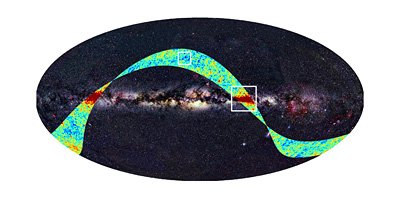I’m happy to be able to point to ESA’s first post-launch press release from the Planck Surveyor Satellite.
Here is a picture of the area of sky that Planck has observed during its “First Light Survey”, superposed on an optical image of the Milky Way galaxy:
(Image credit: ESA, LFI and HFI Consortia (Planck); Background image: Axel Mellinger. More pictures are available on the UK Planck Site as well as in French.)
The last few months since the launch have been a lot of fun, getting to play with Planck data ourselves. Here at Imperial, our data-processing remit is fairly narrow: we compute and check how well the satellite is pointing where it is supposed to, and calculate the shape of its beam on the sky (i.e., how blurry its vision is). Nonetheless, just being able to work at all with this incredibly high-quality data is satisfying.
Because of the way Planck scans the sky, in individual rings slowly stepping around the sky over the course of about seven months, with a nominal mission of two full observations of the sky, even the two weeks of “First Light Survey” data is remarkably powerful: we have seen a bit more than 5% of the sky with about half of the sensitivity that Planck is meant to eventually have (in fact, we hope to extend the mission beyond the initial 14 months). This is already comparable to the most powerful sub-orbital (i.e., ground and balloon-based) CMB experiments to date.
But a full scientific analysis will have to wait a while: after the 14 month nominal mission, we will have one year to analyze the data, and another year to get science out of it before we need to release the data alongside, we hope, a whole raft of papers. So stay tuned until roughly Autumn of 2012 for the next big Planck splash.

One response to “Planck’s First Light”
And the Planck Mission Blog can be found here!